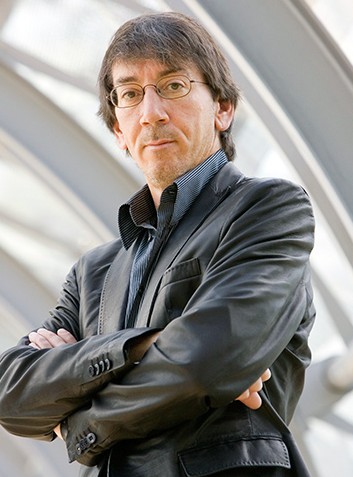-
(b.) - ?1960
Bio/Description
Born in Atlanta, Georgia), he is an American video game designer and co-founder of the game development company Maxis, now part of Electronic Arts (EA). His first game was the helicopter action game Raid on Bungeling Bay (1984) for the Commodore 64. After graduating at 16 from Episcopal High School, he enrolled in Louisiana State University, transferring two years later to Louisiana Tech. Beginning with a start at an Architecture Degree, followed by Mechanical Engineering, he fell into computers and robotics. He excelled in subjects he was interested in?architecture, economics, mechanical engineering, and military history?but was held back by his impractical goals such as language arts. His earlier dream of space colonization remained, and was joined by a love for robotics. After another two years at Louisiana Tech, in the fall of 1980, he moved on to The New School in Manhattan. He lived in an apartment over Balducci?s, in Greenwich Village, and spent his spare time searching for spare parts in local electronics surplus stores. After one year at the New School, he returned to Baton Rouge without his degree, concluding five years of collegiate study. In 1986, he met Jeff Braun, an investor interested in entering the computer game industry, at what he calls "the world's most important pizza party." Together they formed Maxis the next year in Orinda, California. SimCity (1989) was a hit and has been credited as one of the most influential computer games ever made. He has been widely featured in several computer magazines?particularly PC Gamer, which listed him in its annual 'Game Gods' feature, alongside such notables as Roberta Williams and Peter Molyneux. Following the success of SimCity, he designed SimEarth (1990) and SimAnt (1991). He co-designed SimCity 2000 (1993) with Fred Haslam and in the meantime Maxis produced other "Sim" games. His next game was SimCopter (1996). Although none of these games were as successful as SimCity, they further cemented his reputation as a designer of "software toys"?games that cannot be won or lost. He has a great interest in complex adaptive systems and most of his games have been based around them or books that describe them (SimAnt: E.O. Wilson?s The Ants, SimEarth: James Lovelock?s Gaia Theory, SimCity: Jay Forrester?s Urban Dynamics and World Dynamics, Spore: Drake?s equation and The Powers of Ten). His role in the development of the concepts from simulations to games is to empower the players by creating what he dubs ?possibility spaces?, or simple rules and game elements that add up to a very complex design. All Maxis, and later games that he had a hand in designing, adhere to these design principles. EA published The Sims in February 2000 and it became his biggest success yet. It eventually surpassed Myst as the best-selling computer game of all time and spawned numerous expansion packs and other games. He designed a massively multiplayer version of the game called The Sims Online, which was not as popular as the original. In a presentation at the Game Developers Conference on March 11, 2005, he announced his latest game Spore. He used the current work on this game to demonstrate methods that can be used to reduce the amount of content that needs to be created by the game developers. In April 2009 he left Electronic Arts to run "Stupid Fun Club", an entertainment think tank in which he and EA are principal shareholders. The first computer game he designed was Raid on Bungeling Bay in 1984 but it was SimCity that brought him to prominence. The game was released by Maxis, a company he formed with Jeff Braun, and he built upon the game's theme of computer simulation with numerous other titles including SimEarth and SimAnt. His greatest success to date came as the original designer for The Sims games series which, as of 2009, was the best-selling PC game in history. The game spawned multiple sequels and expansions and he earned many awards for his work. His latest work, Spore, was released in September 2008 and features gameplay based upon the model of evolution and scientific advancement. The game sold 406,000 copies within three weeks of its release. In an interview with The Times, he expressed belief that computers extend the imagination, and posits the emergence of the "metabrain", stating: "Any human institutional system that draws on the intelligence of all its members is a metabrain. Up to now, we have had high friction between the neurons of the metabrain; technology is lowering that friction tremendously. Computers are allowing us to aggregate our intelligence in ways that were never possible before. If you look at Spore, people are making this stuff, and computers collect it, then decide who to send it to. The computer is the broker. What they are really exploring is the collective creativity of millions of people. They are aggregating human intelligence into a system that is more powerful than we thought artificial intelligence was going to be." He was given a "Lifetime Achievement Award" at the Game Developers Choice Awards in 2001. In 2002, he became the fifth person to be inducted into the Academy of Interactive Arts and Sciences' Hall of Fame. Until 2006, he was the only person to have been honored this way by both of these industry organizations. In 2007 the British Academy of Film and Television Arts awarded him a fellowship, the first given to a game designer. He has been called one of the most important people in gaming, technology, and entertainment by publications such as Entertainment Weekly, Time, PC Gamer, Discover and GameSpy. He was also awarded the PC Magazine Lifetime Achievement Award in January 2005.
-
Date of Birth:
1960 -
Gender:
Male -
Noted For:
Develop of the computer game, SimCity which has been credited as one of the most influential computer games ever made -
Category of Achievement:
-
More Info:


